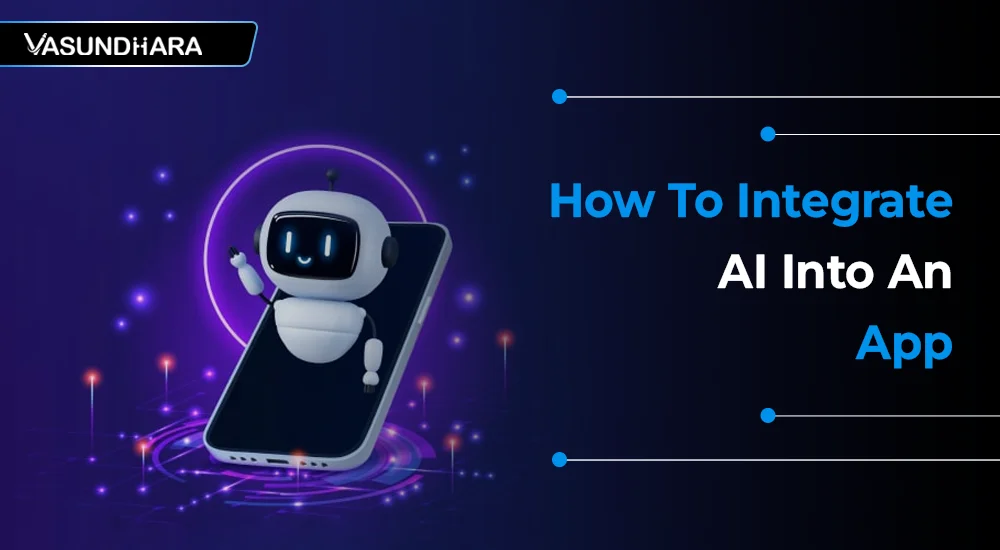Artificial intelligence (AI) is revolutionizing industries, from healthcare to finance, and its impact on app development is no different. Integrating AI into your app can significantly enhance user experience, streamline processes, and provide personalized services that can set your app apart from the competition. As a leading mobile app development company, we at Vasundhara Infotech understand the transformative power of AI and the benefits of integrating into mobile app.
This comprehensive guide will walk you through the steps necessary to integrate AI into your app, from planning to implementation and beyond.
Understanding AI and Its Benefits for Apps
Artificial intelligence refers to the simulation of human intelligence in machines that are programmed to think and learn like humans. AI encompasses a range of technologies, including machine learning (ML), natural language processing (NLP), and computer vision, which enable applications to perform tasks that typically require human intelligence.
Benefits of AI in Apps

- Enhanced User Experience:
AI can improve user experience by offering personalized content, intelligent search capabilities, and efficient customer support through chatbots.
- Improved Efficiency and Automation:
AI can automate repetitive tasks, streamline operations, and increase productivity, allowing developers and users to focus on more critical activities.
- Personalization and Recommendations:
AI algorithms can analyze user behavior and preferences to provide tailored recommendations, enhancing user engagement and satisfaction.
- Data Analysis and Insights:
AI can process vast amounts of data quickly and accurately, providing valuable insights that can inform decision-making and strategy.
Also read: What is Generative AI? Everything You Need to Know
How To Plan AI Integration For Your App
Artificial Intelligence (AI) has rapidly become a transformative force across various industries, including app development. Integrating AI into your app can enhance user experience, improve efficiency, and offer personalized services, thereby providing a competitive edge. However, successful AI integration requires meticulous planning. This guide will walk you through the essential steps to plan AI integration for your app effectively.
Identify Objectives
The first step in integrating AI into your app is to clearly define your objectives. What problems do you want AI to solve? Are you looking to enhance user engagement, automate customer service, or gain insights from data? Clearly defined objectives will guide your AI integration strategy and help you measure its success.
Research and Choose AI Technologies
Once you have identified your objectives, research the AI technologies that best suit your needs. Popular AI technologies include:
Allows systems to learn from data and improve over time without being explicitly programmed.
- Natural Language Processing (NLP):
Enables machines to understand and respond to human language.
Allows machines to interpret and process visual information from the world.
Feasibility Study
Conduct a feasibility study to assess the technical and financial viability of integrating AI into your app. This involves evaluating the required resources, potential ROI, and the complexity of the AI features you plan to implement.
Data Collection
Data is the cornerstone of any AI system. Identify the data you need to train your AI models and determine how you will collect and store this data. Ensure that you comply with data privacy regulations and maintain high standards of data quality.
Also read: How AI is Transforming E-commerce Website Development
How To Select the Right AI Tools and Platforms
Choosing the right AI tools and platforms is crucial for successfully integrating AI into custom mobile app development. The right tools can streamline development, enhance functionality, and ensure scalability. Here’s a comprehensive guide to help you make an informed decision.
AI Development Platforms
Several AI development platforms can help you build and deploy AI services efficiently. Some of the most popular platforms include:
An open-source machine learning framework developed by Google.
An open-source machine learning library developed by Facebook.
Provides powerful AI models and tools for various applications.
AI APIs and Services
If building AI models from scratch is not feasible, consider using AI APIs and services. These pre-built solutions can save time and resources. Some notable AI APIs and services are:
Offers a range of AI and machine learning services.
Provides AI solutions for natural language processing, visual recognition, and more.
Offers a comprehensive set of AI tools and services.
Open Source vs. Commercial Solutions
Decide whether to use open-source tools or commercial solutions. Open-source tools offer flexibility and are cost-effective, while commercial solutions often provide better support and advanced features. Consider your project's specific needs and resources when making this decision.
Also read: The Role of AI and ML in DevOps Transformation
How To Integrate AI into Your App
Integrating AI into your app can transform user experiences, streamline operations, and provide personalized services. Here’s a comprehensive guide to help you seamlessly integrate AI into your app, from planning to deployment and maintenance.

Step 1: Setting Up Your Development Environment
To start integrating AI into your app, set up your development environment with the necessary tools and libraries. Choose programming languages that are well-suited for AI development, such as Python, which has extensive support for machine learning libraries like TensorFlow and PyTorch.
Step 2: Building AI Models
Training Your Models: Use your collected data to train your AI models. This involves feeding data into the model and allowing it to learn patterns and make predictions.
Validating and Testing Your Models: Validate your models to ensure they perform well on unseen data. Use techniques like cross-validation and split your data into training and testing sets to assess model accuracy.
Step 3: Incorporating AI Models into Your App
Backend Integration: Integrate your AI models into the backend of your app. This often involves setting up servers to host your models and creating APIs to interact with them.
Frontend Integration: Implement AI-powered features in the frontend of your app. This can include user interfaces that display AI-driven recommendations, search results, or chatbot interactions.
Step 4: Testing and Debugging
Testing is crucial to ensure the reliability and accuracy of your AI features. Conduct thorough testing to identify and fix any issues. Pay attention to edge cases and ensure your AI performs well under various conditions.
Case Studies and Examples
Successful AI Integrations
Uses machine learning to provide personalized music recommendations and curated playlists.
Utilizes AI for product recommendations, voice-activated assistants (Alexa), and inventory management.
Employs computer vision to organize and categorize photos based on content.
Conclusion
Integrating AI into your app can transform user experiences, streamline operations, and provide valuable insights. By following the steps outlined in this guide—planning, selecting the right tools, integrating, deploying, and maintaining AI features—you can successfully harness the power of AI to enhance your app. Start your AI integration journey today and unlock the potential of artificial intelligence in your app development.
If you require any services for mobile app development, please contact us. We have a team of app development professionals ready to assist your business expand massively in every manner. Explore our diverse portfolio.
You can follow us on all social media platforms, including LinkedIn, Instagram, and Facebook, to stay up to date on the latest technologies and trends.




